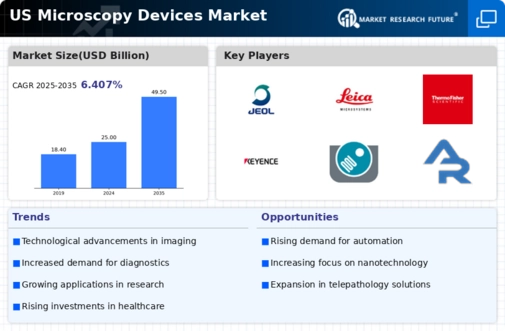Growing Focus on Nanotechnology
The microscopy devices market is poised for growth due to the increasing focus on nanotechnology. As researchers delve into the nanoscale realm, the need for high-resolution imaging tools becomes paramount. Microscopy devices play a crucial role in characterizing nanomaterials and understanding their properties. The US government has recognized the potential of nanotechnology, allocating substantial funding to support research initiatives. This investment is expected to drive the demand for advanced microscopy solutions, as they are essential for the development and application of nanomaterials. The market for nanotechnology-related microscopy is anticipated to expand significantly, potentially reaching $5 billion by 2027.
Rising Demand for Advanced Imaging Techniques
The microscopy devices market is experiencing a notable surge in demand for advanced imaging techniques. This trend is largely driven by the increasing need for high-resolution imaging in various fields, including materials science and biology. As industries seek to enhance their research capabilities, the adoption of sophisticated microscopy technologies, such as super-resolution and electron microscopy, is becoming more prevalent. According to recent data, The market for advanced imaging systems is projected to grow at a CAGR of approximately 8% from 2025 to 2030. This growth reflects the ongoing investment in research and development, as well as the need for precise imaging solutions in both academic and industrial settings.
Expansion of Research and Development Activities
The microscopy devices market is significantly influenced by the expansion of research and development (R&D) activities across various sectors. Increased funding for scientific research, particularly in life sciences and materials engineering, has led to a heightened demand for advanced microscopy solutions. Institutions and laboratories are investing in state-of-the-art microscopy devices to facilitate groundbreaking discoveries. In the US, R&D spending in the life sciences sector alone reached approximately $200 billion in 2025, indicating a robust environment for the growth of the microscopy devices market. This trend suggests that as R&D activities continue to flourish, the demand for innovative microscopy technologies will likely follow suit.
Integration of Artificial Intelligence in Microscopy
The integration of artificial intelligence (AI) into microscopy devices is transforming the microscopy devices market. AI technologies enhance image analysis, automate processes, and improve the accuracy of results. This integration allows researchers to process vast amounts of data more efficiently, leading to faster and more reliable outcomes. As AI continues to evolve, its application in microscopy is likely to expand, offering new capabilities and functionalities. The potential for AI-driven microscopy solutions to streamline workflows and enhance research productivity is driving interest and investment in this area. Consequently, the market for AI-integrated microscopy devices is expected to witness substantial growth in the coming years.
Increased Collaboration Between Academia and Industry
The microscopy devices market is benefiting from increased collaboration between academia and industry. Partnerships between research institutions and commercial entities are fostering innovation and accelerating the development of new microscopy technologies. These collaborations often lead to the creation of cutting-edge devices that meet the specific needs of various sectors, including healthcare and materials science. As academic institutions seek to translate their research into practical applications, the demand for advanced microscopy solutions is likely to rise. This trend indicates a symbiotic relationship that not only enhances the capabilities of the microscopy devices market but also drives technological advancements.

















Leave a Comment